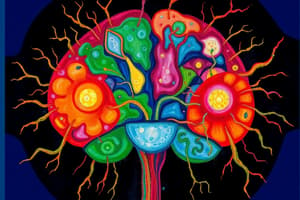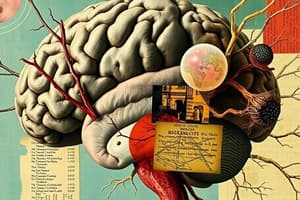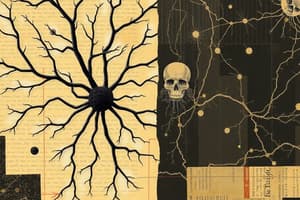Podcast
Questions and Answers
What is the typical value of the resting membrane potential in a neuron?
What is the typical value of the resting membrane potential in a neuron?
- -120 millivolts
- -90 millivolts
- -70 millivolts (correct)
- -50 millivolts
What is the primary function of the peripheral nervous system (PNS)?
What is the primary function of the peripheral nervous system (PNS)?
- Regulate bodily functions
- Transmit sensory information to the CNS and motor commands from the CNS to muscles and glands (correct)
- Integrate and process sensory information
- Initiate motor responses
Which ion is the neuron's membrane more permeable to at rest?
Which ion is the neuron's membrane more permeable to at rest?
- Sodium ions
- Chloride ions
- Potassium ions (correct)
- Calcium ions
What is the main function of dendrites in a neuron?
What is the main function of dendrites in a neuron?
What is the role of the sodium-potassium pump in maintaining the resting membrane potential?
What is the role of the sodium-potassium pump in maintaining the resting membrane potential?
What is the term for neurons that transmit sensory information from sensory receptors to the CNS?
What is the term for neurons that transmit sensory information from sensory receptors to the CNS?
What is the function of the spinal cord in the nervous system?
What is the function of the spinal cord in the nervous system?
What are the three meningeal layers that protect the spinal cord?
What are the three meningeal layers that protect the spinal cord?
Which type of neuron has multiple dendrites and a single axon?
Which type of neuron has multiple dendrites and a single axon?
What is the composition of the spinal cord?
What is the composition of the spinal cord?
What is the axon responsible for in a neuron?
What is the axon responsible for in a neuron?
What is the main function of the cell body in a neuron?
What is the main function of the cell body in a neuron?
What is the direction of potassium ion movement in a neuron at rest?
What is the direction of potassium ion movement in a neuron at rest?
What is the result of the outward movement of positive ions in a neuron at rest?
What is the result of the outward movement of positive ions in a neuron at rest?
Which type of neuron is typically found in sensory ganglia?
Which type of neuron is typically found in sensory ganglia?
What is the function of interneurons in the nervous system?
What is the function of interneurons in the nervous system?
What is the primary function of oligodendrocytes and Schwann cells?
What is the primary function of oligodendrocytes and Schwann cells?
What triggers the opening of voltage-gated sodium channels during the generation of an action potential?
What triggers the opening of voltage-gated sodium channels during the generation of an action potential?
What is the primary mechanism of synaptic transmission?
What is the primary mechanism of synaptic transmission?
What is the role of microglia in the nervous system?
What is the role of microglia in the nervous system?
What triggers the repolarization of the membrane potential during the propagation of an action potential?
What triggers the repolarization of the membrane potential during the propagation of an action potential?
What is the role of astrocytes in the nervous system?
What is the role of astrocytes in the nervous system?
What is the primary function of voltage-gated calcium channels during synaptic transmission?
What is the primary function of voltage-gated calcium channels during synaptic transmission?
What is the primary mechanism of action potential propagation?
What is the primary mechanism of action potential propagation?
Flashcards are hidden until you start studying
Study Notes
Neuroglia in the Nervous System
- Neuroglia, or glial cells, provide support and protection for neurons in the nervous system.
- Types of neuroglia include:
- Astrocytes: provide metabolic and structural support
- Oligodendrocytes and Schwann cells: produce myelin sheaths around axons for insulation and faster signal transmission
- Microglia: function as immune cells
- Ependymal cells: produce cerebrospinal fluid and line the cavities of the brain and spinal cord
Generation and Propagation of an Action Potential
- An action potential is a rapid, transient change in the membrane potential of a neuron that propagates along the axon.
- It is generated when the membrane potential reaches a threshold level, causing voltage-gated sodium channels to open, leading to a rapid influx of sodium ions and depolarization of the membrane.
- This depolarization triggers neighboring voltage-gated sodium channels to open, propagating the action potential along the axon.
- After reaching its peak, the membrane potential repolarizes as voltage-gated potassium channels open and potassium ions exit the cell, restoring the membrane potential to its resting state.
Mechanisms of Synaptic Activity
- Synaptic activity involves the release of neurotransmitters from the presynaptic neuron into the synaptic cleft, where they bind to receptors on the postsynaptic neuron, initiating a response.
- Neurotransmitter release is triggered by the arrival of an action potential at the presynaptic terminal, leading to the opening of voltage-gated calcium channels and influx of calcium ions.
- The calcium influx triggers the fusion of synaptic vesicles containing neurotransmitters with the presynaptic membrane, releasing neurotransmitters into the synaptic cleft.
Anatomical and Functional Divisions of the Nervous System
- The nervous system is divided into two main anatomical divisions: the central nervous system (CNS) and the peripheral nervous system (PNS).
- The CNS consists of the brain and spinal cord, which integrate and process sensory information, initiate motor responses, and regulate bodily functions.
- The PNS consists of nerves and ganglia outside the CNS and serves to transmit sensory information to the CNS and motor commands from the CNS to muscles and glands.
- Functionally, the nervous system is divided into sensory (afferent) neurons, which transmit sensory information from sensory receptors to the CNS, and motor (efferent) neurons, which transmit motor commands from the CNS to muscles and glands.
Structure of a Typical Neuron
- A neuron consists of three main parts: the cell body (soma), dendrites, and axon.
- The cell body contains the nucleus and other organelles responsible for cellular functions.
- Dendrites are branched extensions that receive incoming signals from other neurons or sensory receptors.
- The axon is a long, slender projection that carries electrical impulses away from the cell body toward other neurons, muscles, or glands.
Classification of Neurons
- Neurons can be classified based on their structure into three main types: multipolar, bipolar, and unipolar.
- Multipolar neurons have multiple dendrites and a single axon, and are the most common type in the CNS.
- Bipolar neurons have one dendrite and one axon and are found in specialized sensory organs like the retina of the eye and the olfactory epithelium.
- Unipolar neurons have a single process emerging from the cell body that divides into both dendritic and axonal branches, and are typically found in sensory ganglia.
- Neurons can also be classified based on their function as sensory (afferent), motor (efferent), or interneurons (association neurons) that connect sensory and motor neurons within the CNS.
Resting Membrane Potential
- The resting membrane potential is the electrical potential difference across the plasma membrane of a neuron when it is not transmitting signals.
- It is typically around -70 millivolts (mV) and is maintained by the selective permeability of the membrane to ions, particularly potassium (K+) and sodium (Na+), and the activity of ion pumps such as the sodium-potassium pump.
- The sodium-potassium pump actively transports sodium ions out of the cell and potassium ions into the cell, contributing to the negative internal charge of the neuron.
Structure and Functions of the Spinal Cord
- The spinal cord is a cylindrical bundle of nerve fibers that extends from the brainstem through the vertebral canal of the spinal column.
- It serves as the main pathway for transmitting sensory information from the body to the brain and motor commands from the brain to the body.
- The spinal cord is protected by three meningeal layers: the dura mater (outer layer), arachnoid mater (middle layer), and pia mater (inner layer).
Spinal Cord Structure and Role of White and Grey Matter
- The spinal cord consists of grey matter and white matter.
Studying That Suits You
Use AI to generate personalized quizzes and flashcards to suit your learning preferences.




